In today’s data-driven business environment, the importance of effectively synthesizing information from multiple sources cannot be overstated. A well-crafted data integration report not only provides clarity and insight but also drives strategic decision-making across all levels of an organization.
Yet, creating such a report can be daunting, especially without a clear roadmap. In this blog post, we’ll demystify the steps and strategies involved in developing an impactful data integration report, ensuring you can deliver clear and actionable insights every time.
The Foundation of a Strong Data Integration Report: Clarity and Structure
Before diving into data collection and analysis specifics, the first step is establishing a clear and structured framework for your report. This involves defining the report’s scope, understanding the data sources, and determining the objectives. A well-structured data integration report ensures that the data collected is relevant, the analysis is insightful, and the findings are easily understandable.
Start by identifying the key metrics and data points that are crucial to the objectives of the report. This alignment ensures that every piece of data gathered has a purpose and contributes directly to the overarching goals of the project. Moreover, organizing the data coherently within the report aids in guiding the reader through your findings logically, enhancing the overall impact of the report.
Bridging Data Sources: The Core of Effective Integration
Managing data from various sources is one of the most challenging aspects of crafting a data integration report. Ensuring that these disparate data streams are accurately and effectively combined is crucial for a meaningful analysis. This process involves technical know-how and a strategic understanding of the data’s origin and implications.
Begin by establishing protocols for data extraction and transformation. This includes standardizing data formats, validating data accuracy, and resolving discrepancies between data sets. The goal is to create a unified database where all information is compatible and ready for analysis. Remember, the integrity of your data integration report relies heavily on the quality and consistency of the data integrated.
Analyzing Data: Turning Information into Insights
With your data now harmonized, the next step involves deep analysis to extract actionable insights. This phase is where your technical skills and business acumen come into play. You must explore patterns, trends, and correlations within the data using various analytical tools and techniques.
Effective analysis often requires a balance between quantitative methods and qualitative insights. For instance, while statistical tools can highlight trends, your interpretation will turn these findings into valuable insights. Ensure that your analysis speaks directly to the goals set out in the initial stages of the report, and always keep the end-user in mind. The insights you provide should be relevant and accessible to those who need them.
Visualizing Data: Enhancing Understanding Through Design
A critical yet often overlooked aspect of the data integration report is how the data is presented. Visualization plays a key role in how your findings are perceived and understood. By using charts, graphs, and infographics, you can enhance the readability of your report and make complex data more digestible.
Choose visuals that best represent the data and support the narrative of your report. For example, use a bar graph to show comparisons or a line graph to depict trends over time. Each visual should add value to the report and help emphasize the key findings. Also, ensure that your visuals are not only attractive but also accurately represent the underlying data.
Crafting the Narrative: Tying It All Together
After analyzing and visualizing your data, the next step is to craft the narrative of your report. This involves writing the content that will accompany your visuals and guide the reader through your insights. The narrative should be clear, concise, and focused on the report’s objectives.
Use headings and subheadings to organize the content and guide the reader through your findings. Each section should flow logically to the next, building on previously presented information. The narrative should present the data and explain its significance, offering conclusions and recommendations based on the analysis.
The Final Touch in Your Data Integration Report
In conclusion, crafting an effective data integration report is a meticulous process that requires a deep understanding of both the data and the objectives of the report. From structuring your report with clarity to integrating data from multiple sources, analyzing the information, visualizing the results, and crafting a compelling narrative, each step plays a pivotal role in the success of the final document.
As we’ve explored, the impact of a well-executed data integration report extends beyond mere data presentation; it influences decision-making, strategy development, and operational efficiencies. By following the guidelines discussed, you can enhance your ability to handle vast amounts of data and transform them into strategic insights that can propel your organization forward. Embrace the challenge, and let your data integration report be a testament to the power of informed, data-driven decision-making.
Read More:
Power of Data Integration



